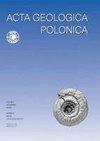Early Pliocene calcareous and siliceous microfossils of the Sawai Bay Formation, Car Nicobar Island, northern Indian Ocean
IF 0.9
4区 地球科学
Q3 GEOLOGY
引用次数: 2
Abstract
The present contribution provides a study of calcareous nannofossils and siliceous microfossils from the Sawai Bay Formation on Car Nicobar Island, northern Indian Ocean. Two stratigraphically short sediment intervals near Sawai Bay have been examined. Qualitative and quantitative microfossil analyses show the Sawai Bay ‘A’ Section to be devoid of siliceous microfossils, while 24 well-preserved calcareous nannofossil taxa are identified. The Sawai Bay ‘B’ Section yields 18 calcareous nannofossil, 33 radiolarian and 25 diatom taxa. The calcareous nannofossil index taxa ( Ceratolithus armatus Muller, 1974a and C. cristatus Kamptner, 1950) indicate both sections to be from zones NN12 (CN10b) and NN13 (CN10c) of early Pliocene (Zanclean) age. The radiolarian taxa, i.e., Didymocyrtis avita Riedel, 1953, Euchitonia spp., Siphocampe lineata (Ehrenberg) Nigrini, 1977, Stichocorys peregrina Riedel, 1953, Semantis spp. and Stylochlamydium sp. are common in the Sawai Bay ‘B’ Section, which is assigned to Zone RN9. Most of the diatom taxa are represented by representatives of the genera Actinocyclus Ehrenberg, 1837, Azpeitia Peragallo in Tempere and Peragallo, 1912, Coscinodiscus Ehrenberg, 1839a, Grammatophora Ehrenberg, 1841 and Triceratium Ehrenberg, 1839b, with the benthic diatom species Triceratium favus Ehrenberg, 1839b being predominant (~35% of the total diatom count). Siliceous microfossils are also represented by silicoflagellates dominated by Dictyocha spp. and sponge spicules dominated by astrophorids.印度洋北部卡尔尼科巴岛Sawai湾组上新世早期钙质和硅质微体化石
本论文研究了北印度洋卡尔尼科巴岛Sawai湾组的钙质超微化石和硅质微体化石。对Sawai湾附近的两个地层短沉积层段进行了检查。定性和定量的微体化石分析表明,Sawai湾“A”剖面没有硅质微体化石,同时确定了24个保存完好的钙质超微化石分类群。Sawai湾'B'剖面产生了18个钙质超微化石、33个放射虫和25个硅藻分类群。石灰质超微化石指数分类群(Ceratolysus armatus Muller,1974a和C.cristus Kamptner,1950)表明这两个剖面都来自上新世早期的NN12(CN10b)和NN13(CN10c)带。放射虫分类群,即Didyocytis avita Riedel,1953年,Euchitonia spp.,Siphocampe lineata(Ehrenberg)Nigrini,1977年,Stichocorys peregrina Riedel(1953年),Semantis spp.和Stylochlamydium spp.在Sawai湾'B'剖面中很常见,该剖面被划分为RN9区。大多数硅藻分类群以Actinocyclus Ehrenberg属(1837)、Tempere和Peragallo的Azpeitia Peragallos属(1912)、Coscinodiscos Ehrenberg属(1839a)、Gramatophora Ehrenbrg属(1841)和Tricerium Ehrenbberg属(1839 b)的代表为代表,其中底栖硅藻物种Tricerium favus Ehreenberg属(183 9b)占主导地位(约占硅藻总数的35%)。硅质微体化石也以Dictyocha spp.为主的硅鞭毛虫和星形藻类为主的海绵针状物为代表。
本文章由计算机程序翻译,如有差异,请以英文原文为准。
求助全文
约1分钟内获得全文
求助全文
来源期刊

Acta Geologica Polonica
地学-地质学
CiteScore
1.70
自引率
18.20%
发文量
0
审稿时长
>12 weeks
期刊介绍:
Acta Geologica Polonica publishes original and review papers on all aspects of basic geology, with particular focus on sedimentology, stratigraphy, palaeontology, regional geology, structural geology, and regional petrography. All papers are published in English.
 求助内容:
求助内容: 应助结果提醒方式:
应助结果提醒方式:


